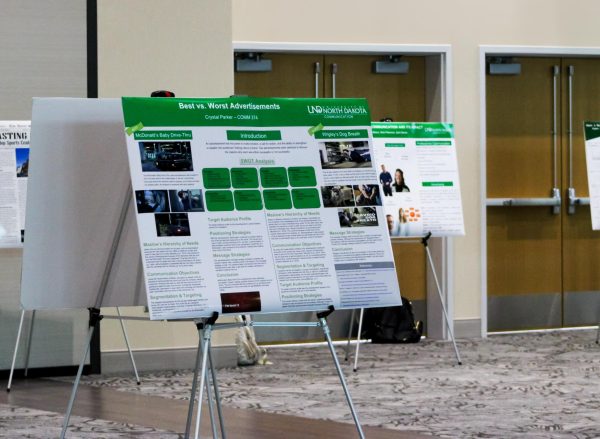Shale booms shift voter preference
A recent study reached the conclusion that areas that experience shale oil booms are much more likely to elect Republican candidates to office.
This past Monday, Erik Gilje, an assistant professor of finance at Wharton School of the University of Pennsylvania, gave a presentation at UND on how voter preferences influence political outcomes, using shale oil development in certain regions to measure the change in voter preferences.
Gilje began the presentation with two hypotheses on how politicians react to changing voter preference.
“One, politicians alter their views to adapt to the voters, or two, that they don’t, and essentially the mechanism by which voter preference translates to political change is that you essentially have to go out and hire new politicians to represent you,” Gilje said.
Gilje, along with co-authors Viktar Fedaseyeu and Philip E. Strahan, concluded four key findings from their research: support for Republican candidates increases in areas that experience shale oil booms, Democrat incumbents lost more frequently to Republican challengers, Republicans elected to office were more conservative on a variety of issues and Democrats who voted conservatively in an attempt to hold their seats did not increase their likelihood of reelection.
Gilje used data for seven states that experienced shale booms:
Arkansas, Louisiana, North Dakota, Oklahoma, Pennsylvania, Texas and West Virginia. The data for the political outcomes came from U.S. Senate, U.S. House of Representatives, governor and presidential elections from 1996 to 2012.
Hydraulic fracturing — commonly referred to as “fracking” — of shale formations in order to access oil and natural gas was pioneered by George Mitchell in Texas. Mitchell is commonly referred to as the “father of fracking,” and the practice began to be commonly used in certain areas of the U.S. beginning in 2003.
“Here is the idea: There is going to be this big shock that occurs due to this technological breakthrough, and then we’re going to see whether voter processes changed because of this,” Gilje said.
His study found in the average shale boom district, Republicans gained a 3.2 percent share of the vote if they were running against a Democrat. However, they did not find that voters’ behavior was noticeably shifted in districts with Republican incumbents.
Less than 50 percent of the House seats in the shale boom areas were held by Republicans in 1996. By 2012, 80 percent of these seats were held by Republicans.
Additionally, the study found that in congressional districts that experienced a shale oil boom, close to six percent of self-identified Democrats voted for Republicans, while less than three percent of Republican voters voted for Democrats. In non-shale boom districts, more Republican voters were likely to support Democratic candidates than vice versa.
Gilje used data from Americans for Democratic Action to measure a politician’s position on the political spectrum. He also used political position metrics from three left-leaning interest groups — the AFL-CIO, the ACLU and League of Conservation Voters — and three right-leaning interest groups — the American Conservative Union, the Chamber of Commerce and the National Taxpayers Union — to measure how conservative or liberal elected officials were throughout the study.
He found that politicians had more conservative policy positions on a variety of topics in areas that experienced a shale oil boom.
“When this well development occurs, you see that they do worse on their liberal scoring metrics and better on their conservative metrics,” Gilje said. “What this suggests is that essentially there are potentially a lot of spillovers to other types of policy. We think this highlights how through representative democracy you can change in one area, which results in policy changes in other areas.”
Gilje described the study’s findings on how Democratic incumbents fared on average if they attempted to shift their policy positions to better match the electorate.
“Even those Democrats that tried to change or adapt their views were not successful in terms of the public credibly believing that their views had changed,” Gilje said.
This finding supported the hypothesis that most politicians hold to their political views and that political change occurs through voters electing different representatives to office, rather than politicians shifting their policy positions.
Gilje’s presentation was part of a series of seminars hosted by UND’s economics department.
Sean Cleary is the editor-in-chief for The Dakota Student. He can be reached at sean.cleary@und.edu







